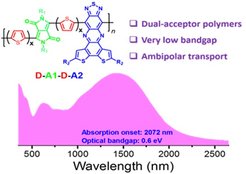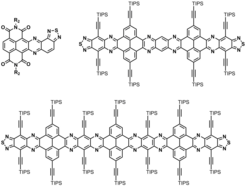Conjugated Copolymers for Ambipolar Field-Effect Transistors
Keywords: Conjugated Copolymers, Ambipolar Field-Effect Transistors, OFET


Starting from polycyclopentadithiophene-benzothiadiazoles (PCPDT-BTZ) we further concluded to strengthen the acceptor part upon introducing thiadiazoloquinoxalines (TQ) as a strong acceptor unit for organic electronics leading to a lowering of the LUMO levels and more suited ambipolar character. Upon condensation of the diamino benzothiadiazoles with benzodithiophene-dione the acceptor part could be further strengthened and open a variety of new copolymers as PBDTTQ-2(203,218,230,232) (Fig. 1) and many small molecule acceptor structures with different electronic properties as indicated from their optical absorptions, cyclic voltammetry (CV) data, density functional theory (DFT) and time dependent (TD-DFT) calculations.(229,241) Also different acceptor units can be merged into copolymers with extremely low band-gap as shown here for diketopyrrolopyrol (DPP) and thiadiazoloquinoxaline (TQ) (Figure 2).(239) Finally we demonstrated how the thiadiazoloquinoxaline units can be merged with other acceptors(271) like naphthalenediimide (NDI) and be extended in an iterative way to extremely long condensed pyrene-fused heteroacenes with TQ end groups just by ring opening of the thiadiazole five membered ring followed by further condensations in an iterative way (Fig. 3). (280)



